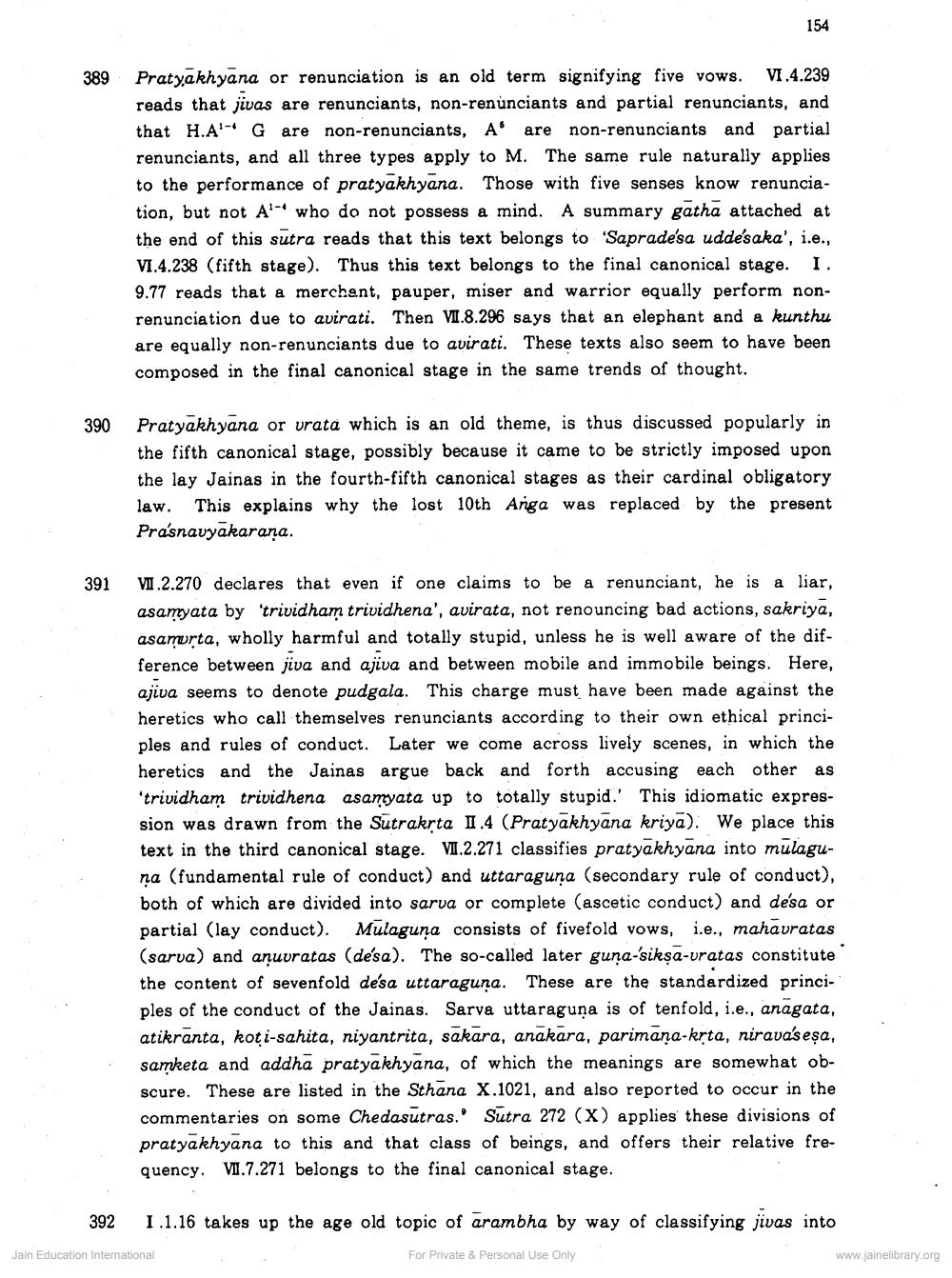________________
154
389
Pratyakhyana or renunciation is an old term signifying five vows. V1.4.239 reads that jivas are renunciants, non-renunciants and partial renunciants, and that H.A - G are non-renunciants, ATM are non-renunciants and partial renunciants, and all three types apply to M. The same rule naturally applies to the performance of pratyakhyana. Those with five senses know renunciation, but not Al- who do not possess a mind. A summary gatha attached at the end of this sutra reads that this text belongs to 'Saprade'sa udde'saka', i.e., VI.4.238 (fifth stage). Thus this text belongs to the final canonical stage. I. 9.77 reads that a merchant, pauper, miser and warrior equally perform nonrenunciation due to avirati. Then VI.8.296 says that an elephant and a kunthu are equally non-renunciants due to avirati. These texts also seem to have been composed in the final canonical stage in the same trends of thought.
390
Pratyakhyana or vrata which is an old theme, is thus discussed popularly in the fifth canonical stage, possibly because it came to be strictly imposed upon the lay Jainas in the fourth-fifth canonical stages as their cardinal obligatory law. This explains why the lost 10th Anga was replaced by the present Prasnavyakarana.
391
V1.2.270 declares that even if one claims to be a renunciant, he is a liar, asamyata by 'trividham trividhena', avirata, not renouncing bad actions, sakriya, asamurta, wholly harmful and totally stupid, unless he is well aware of the difference between jiva and ajiva and between mobile and immobile beings. Here, ajiva seems to denote pudgala. This charge must have been made against the heretics who call themselves renunciants according to their own ethical principles and rules of conduct. Later we come across lively scenes, in which the heretics and the Jainas argue back and forth accusing each other as 'trividham trividhena asamyata up to totally stupid.' This idiomatic expression was drawn from the Sutrakrta 1.4 (Pratyakhyana kriya). We place this text in the third canonical stage. VI.2.271 classifies pratyakhyāna into mulaguņa (fundamental rule of conduct) and uttaraguna (secondary rule of conduct), both of which are divided into sarva or complete (ascetic conduct) and desa or partial (lay conduct). Mulaguna consists of fivefold vows, i.e., mahavratas (sarva) and anuuratas (desa). The so-called later guna-sikşa-vratas constitute the content of sevenfold desa uttaraguna. These are the standardized principles of the conduct of the Jainas. Sarva uttaraguna is of tenfold, i.e., anagata, atikranta, koti-sahita, niyantrita, sakara, anakara, parimana-krta, nirava's eșa, samketa and addha pratyakhyana, of which the meanings are somewhat obscure. These are listed in the Sthana X.1021, and also reported to occur in the commentaries on some Chedasutras.' Sutra 272 (x) applies these divisions of pratyakhyana to this and that class of beings, and offers their relative frequency. VII.7.271 belongs to the final canonical stage.
392
1.1.16 takes up the age old topic of arambha by way of classifying jivas into
Jain Education International
For Private & Personal Use Only
www.jainelibrary.org




